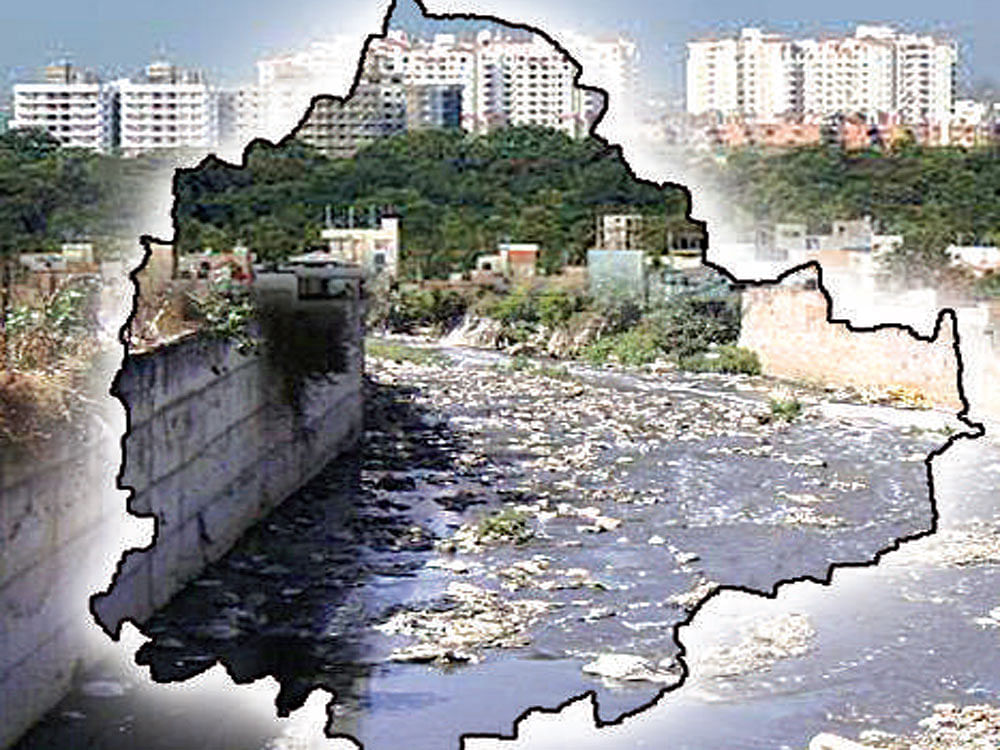
The demolition of structures on rajakaluves (storm water drains-SWDs), even though with approvals and No Objection Certificates given by dishonest officials, are continuing and will carry on for four months till the 1,913 structures so identified are removed, according to the Bruhat Bengaluru Mahanagara Palike (BBMP).
What is overlooked in this drive is the unintended consequences of such knee-jerk action obviously following the court directions. Firstly, the demolished areas look like Syrian war zones with debris strewn over. If these concrete chunks are not removed, they will be blocking the rajakaluves which will further block the flow of storm water and sewage in these SWDs.
More importantly, even if the BBMP finds contractors to remove debris far away from the city limits, further causing floods in those areas, the clearing up of the rajakaluves will aggravate the flood problem when another 4-inch rain is likely in November-December due to the customary depression in the Bay of Bengal. What is the reason for this?
The lake encroachment in the Urban District alone is 4,277 acres and out of 835 lakes, only 85 are devoid of encroachments. This is as per the 2007 Joint Legislature (Ramaswamy) Committee Report and The Task Force Report (2011), both of which have been shelved by the government, and the latest Joint Legislative Committee on Lake Encroachments in Bengaluru Urban and Rural Districts.
Worse, there are nearly 50 lakes in the BBMP area which have been breached by the government itself and bus terminus, layouts, stadiums, golf courses, medical colleges and other buildings have come up during the past 30 years or so.
Some samples are: Siddapura Lake – Jayanagar I Block; Shule Tank – Football Stadium; Sampige Lake – Kanteerava Stadium; Akkithimmanahalli Lake – Hockey Stadium; Dharmabudhi Lake – Kempe Gowda Central Bus Terminus; Koramangala Lake – National Dairy Research Institute; Hennur Lake – HBR Layout; Vijnanapura Lake (Kotturu) – Rajarajeswari Layout; Gokula Lake—Mathikere Layout; Jakkarayanakere – Krishna Flour Mills; and, Challagatta Lake – Karnataka Golf Club. The list is disgracefully long.
Consider for a moment: what happens when the Rajakaluves are cleared of encroachments, and rainwater and sewage (they are inseparable) flows into these natural low-grounds which are now built upon. The rushing water in the opened-up rajakaluves will flood these erstwhile lake areas and people living on these lake beds will have to be rescued by boats!
A look at the map of rajakaluves in BBMP’s eight zones will show that many rajakaluves do not join lakes while the original purpose of rajakaluves was to carry excess water from higher level lakes to lower lakes in a Cascading Lake System perfected by Col Hieram Sankey, chief engineer of the East India Company in the 19th century.
The present Sankey Tank built in 1882 is named after him. The Sankey Tank was linked to the Millers Tank and Dharmabudhi tank for drinking water supply after the famine of 1876-78. Sankey Tank was originally 37 acres of which over eight acres are claimed by various persons including a big “ministerial” builder!
The logical step is to first remove encroachments inside the lakes which are the nature’s most effective rainwater harvesting method and then to remove the encroachments on the rajakaluves which bring water to the lakes. Instead, what is being done is the proverbial Tenali Raman act of trying to catch the bull by its tail leaving aside the nose rope.
Property Ownership Rights
What is necessary is to implement the Urban Property Ownership Rights (UPOR) project. Under this, the Survey Department measures each property in the Bengaluru Urban area after a proper enquiry. It issues a Property Card with a map certified by the government which becomes a Document of Title in place of the present bribed Deed of Registration by the Sub-Registrar.
For its population of 110 lakh, the city has 24 lakh house-properties and the UPOR project will cost Rs 120 crore in three years. The cost can easily be recovered from the grateful house-owners who will not hesitate to pay even Rs 500 for the Ownership Certificate.
The people of Bengaluru have not learnt any lesson from the Chennai flood of November 2015 when 19-inch rain fell on the city in 24 hours. Chennai had over 600 lakes even in 1980 but by 2008, the area of its major lakes shrank from 2,870 acres to 1,638 acres, over 300 water bodies had disappeared and on its SWDs of 855 km (same as Bengaluru’s 840 km), the Madras Metropolitan Area Development Authority (MMDA) had given permission for 1.5 lakh buildings to come up. As a result, when an extreme event of 490 mm rain fell on one day, the city flooded and 517 persons died.
Nassim Nicholas Taleb, in his seminal Black Swan, points out that historically, “unexpected events” – which are exceptional and outside the main frame of the bell-shaped normal curve and in its “tails” -nevertheless happen in history again and again and therefore, should be expected, but people become complacent about them.
Taleb also gives the example of the happy turkey which is being well-fed for the Thanksgiving dinner. The unsuspecting turkey thinks how generous the human beings are to feed him with rich food every day. But, come Wednesday before the Thanksgiving, the world of turkey ends as it is fattened only for the slaughter.
The people of Bengaluru are like the happy turkey not realising what is in store for them. When asked what is their main grievance redress desired for the 2015 New Year was, some techies replied that the police should extend the night hours for celebrations up to 1 am in the morning.
This has been done now. The èlite of Bengaluru, in their high rise apartments and gated communities, do not realise that the party will soon be over unless the water problem is dealt with very seriously and very soon.
(The writer is former Additional Chief Secretary, Government of Karnataka)